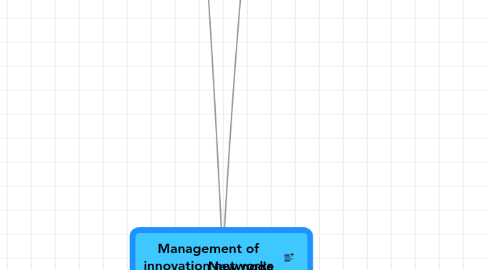
1. B. Innovation Management (nico)
1.1. Strategic
1.1.1. Vision, mission, culture
1.1.1.1. Factors fostering innovation
1.1.2. Planning
1.1.2.1. Competencies
1.1.2.2. Technologies
1.2. Human Resources
1.2.1. Organizational design (Job analysis)
1.2.1.1. Key players
1.2.2. Recruiting and selection
1.2.3. Performance appraisal
1.2.4. Training and development
1.2.5. Compensation and benefits
1.2.6. Organization Change, Development & Learning
1.3. Operations
1.3.1. Innovation process stages
1.3.1.1. Initial shock to organization
1.3.1.2. Creative process
1.3.1.2.1. Preparation
1.3.1.2.2. Incubation
1.3.1.2.3. Intimation
1.3.1.2.4. Insight
1.3.1.2.5. Verification, elaboration and application
1.3.1.3. Ideas proliferate
1.3.1.3.1. Setbacks and surprises are likely to occur
1.3.1.4. Opportunities for trial-and-error learning, blending of old and new ideas
1.3.1.5. Organization restructuring
1.3.1.5.1. Technical development
1.3.1.5.2. Commercialization
1.3.1.6. Hands-on approach of top management through all the process
1.4. Marketing
1.4.1. Marketing information systems
1.4.2. Marketing control systems
1.4.2.1. Multichannel communication & monitoring
1.4.2.2. CEM customer experience management
1.4.2.2.1. Value co-creation
1.4.2.3. Innovation process
1.4.2.3.1. Social network generates the idea
1.4.2.3.2. Innovators concentrate the idea
1.5. R&D performance measurement
1.5.1. Process indicators
1.5.1.1. Concept generation
1.5.1.2. Product development
1.5.1.3. Process innovation
1.5.1.4. Technology acquisition
1.5.1.5. Others
1.5.1.5.1. Leadership
1.5.1.5.2. Resourcing
1.5.1.5.3. Systems and tools
1.5.1.5.4. Increased competitivness
1.5.2. Performance Measurement Systems for R&D units
1.5.2.1. Objectives
1.5.2.2. Dimensions performance
1.5.2.2.1. Financial
1.5.2.2.2. Customer
1.5.2.2.3. Internal processes
1.5.2.2.4. Learning & growth
1.5.2.3. Control objects
1.5.2.3.1. Functional department
1.5.2.3.2. Project team
1.5.2.3.3. R&D unit
1.5.2.3.4. Individuals
1.5.2.4. Indicators
1.5.2.4.1. Quantitative
1.5.2.4.2. Qualitative
1.5.2.5. Measurement process
1.5.2.5.1. Frequency
1.5.2.5.2. Targets
1.5.3. contribution of R&D to value creation
1.5.3.1. Synthetic indexes
1.5.3.2. The Technology Value Pyramid (TVP)
1.5.3.2.1. R&D link to strategic goals
1.5.3.2.2. R&D operational performance
1.6. Knowledge management
1.6.1. Cognitive network
1.6.2. Community network
2. C. Network Management (nico)
2.1. Strategic
2.1.1. Network elements
2.1.1.1. Nodes
2.1.1.1.1. Resources
2.1.1.1.2. Activities
2.1.1.1.3. Actors
2.1.1.2. Links (relationships)
2.1.1.2.1. Competitiveness
2.1.1.2.2. Complementarity
2.1.2. Key network levels
2.1.2.1. Industries as network
2.1.2.2. Firms in network
2.1.2.3. Relationship portfolio
2.1.2.4. Exchange relationship
2.1.3. Network Management method definition
2.2. Management of Business networks (in general)
2.2.1. Size
2.2.2. founders team
2.2.3. Successful vs Failure Business Network
3. New node
4. D. Existing models for Management of innovation networks (naty)
4.1. Approaches to management in innovation networks
4.1.1. Transaction costs theory
4.1.2. Social Capital Theory
4.1.3. Hub firms and Orchestration
4.1.4. Nature of the innovation network
4.1.4.1. Rigid
4.1.4.1.1. Temporary network duration (project)
4.1.4.1.2. Profits as rewards
4.1.4.1.3. Network as a mean for complementary resources
4.1.4.1.4. Traditional organization
4.1.4.1.5. Planning and control are important
4.1.4.1.6. Hierarchies should be avoided (one coordinator is needed)
4.1.4.2. Free
4.1.4.2.1. Continuous network duration
4.1.4.2.2. Self-fulfillment and friendship as rewards
4.1.4.2.3. Network as an end for self-fulfillment
4.1.4.2.4. Virtual organization
4.1.4.2.5. Trust is important
4.1.4.2.6. Hierarchies should be avoided (one coordinator is needed)
4.1.5. Virtual Organizations
4.2. Central success factors
4.3. Management and control in Innovation Networks
4.3.1. Theory O and E
5. A. Innovation networks (naty)
5.1. Innovation
5.1.1. Innovation Definitions
5.1.2. Types of innovation
5.1.2.1. Product
5.1.2.2. Process
5.1.2.3. Incremental
5.1.2.4. Radical
5.1.2.5. Position
5.1.2.6. Paradigm
5.1.2.7. Systemic
5.1.2.8. Autonomous
5.1.3. Innovation Strategies
5.2. Networks
5.2.1. Definition of busines network
5.2.2. Types of Business networks
5.2.2.1. According to their structure
5.2.2.1.1. Horizontal
5.2.2.1.2. Vertical
5.2.2.2. By capital intensity
5.2.2.2.1. With high concentration of capital goods
5.2.2.2.2. Without high concentration of capital goods
5.2.2.3. By level of aggregation
5.2.2.3.1. Simple Networks
5.2.2.3.2. Network of networks
5.2.3. Network vs clusters
5.2.4. Advantages and obstacles of Business Networks
5.2.5. Economic Agents
5.3. Open Innovation
5.3.1. Levels of analysis
5.3.1.1. Individuals or Intra-organizational networks
5.3.1.2. Firm Level
5.3.1.3. Dyad level
5.3.1.4. Inter-organizational Networks level
5.3.1.5. National or regional systems level
5.4. Innovation Networks
5.4.1. Definition
5.4.2. Knowledge Flows
5.4.3. Ties in innovation Networks
5.4.4. Key institutions
5.4.5. Innovation Networks as a worldwide movement
5.4.6. Advantages & Disadvantages
5.4.7. Areas of application
5.4.8. Types
5.4.8.1. cross-sectoral
5.4.8.2. multi-disciplinary
5.4.9. The ideal Innovation Network
